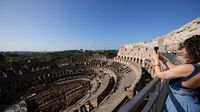Rome’s iconic Colosseum, a monument to ancient grandeur and the city’s most-visited attraction, has found itself at the center of a modern misunderstanding. Simone Quilici, who took the helm as director of the Archaeological Park of the Colosseum on October 20, 2025, has had to clarify his vision after rumors of wild electronic dance music (EDM) parties sent social media into a frenzy and raised eyebrows among archaeologists, locals, and music fans alike.
Earlier this month, Quilici discussed his aspirations to bring concerts and cultural performances to the nearly 2,000-year-old amphitheater. Almost immediately, social media platforms began buzzing with talk of “massive raves,” complete with AI-generated images of laser lights beaming from the ancient arena. The idea of thumping bass reverberating through the stone walls of the Colosseum was enough to alarm not just cultural purists, but even some electronic music enthusiasts, who worried about the potential damage such vibrations could inflict on the delicate structure. As reported by AP, Quilici faced a wave of concern from archaeologists and ordinary Romans, all fiercely protective of their city’s heritage.
Speaking to The Associated Press in his first interview with foreign media since assuming his new post, Quilici was keen to set the record straight. “The music must be carefully controlled. I mentioned certain artists — not by accident — who haven’t been ‘rock’ for some time, who play calm music and attract a calm audience, because the important thing is that it’s not a wild crowd,” he said. “I joked about rock in moderation — that’s what I meant, a more subdued kind of music. But it was reported the opposite of what I said.”
So, what’s actually in store for the Colosseum under Quilici’s stewardship? Forget the visions of glow sticks and pounding EDM. Instead, Quilici envisions the amphitheater as a venue for acoustic or jazz concerts, poetry readings, dance performances, and theater productions. He even cited Sting as an example of the type of artist who could grace the ancient stage. But don’t expect to buy tickets anytime soon: “The Colosseum’s first concerts and performances will take place in no less than two years,” Quilici confirmed. These events, he emphasized, would be special, intimate, and respectful of the site’s immense historical and religious significance.
It’s not as though the Colosseum is a stranger to music. Only a handful of concerts have taken place there over the years — Ray Charles in 2002, Paul McCartney in 2003, and Andrea Bocelli in 2009 — all with severely restricted audiences and billed as unique occasions. Quilici’s plans would follow in this tradition, focusing on quality over quantity and ensuring that the amphitheater remains, as he called it, a “sacred space.” Today, the Colosseum is more than a tourist attraction. It’s the setting for the annual Via Crucis (Way of the Cross) Easter procession, presided over by the pope, and holds a special place in Roman identity.
Beyond music, Quilici’s ambitions extend to other forms of cultural enrichment. He is planning for historical reenactments of gladiatorial battles, but with a twist: these would be rooted in academic research and scientific accuracy, a far cry from the costumed centurions who prowl the Colosseum at night, pestering tourists for paid photos. “There are people who are extremely knowledgeable about daily life in past eras, with a remarkable level of scientific accuracy. So these activities are very welcome within the Colosseum park,” Quilici explained.
But why not capitalize on the Colosseum’s global fame and pack in as many events and visitors as possible? For Quilici, the answer is simple: sustainability and respect. The Colosseum is already bursting at the seams. According to data provided by the park and reported by AP and Mathrubhumi, nearly 9 million people visited the site in 2024, up from 7 million the previous year. Even in October, well outside the peak tourist season, the ancient arena teems with visitors — a surge driven in part by the Vatican’s Jubilee Year, held once every quarter-century, which continues to attract large groups of pilgrims to Rome.
Quilici is acutely aware that the Colosseum is just one piece of a much larger archaeological puzzle. The park he oversees also includes the Roman Forum, the beating heart of ancient Roman society, and Palatine Hill, where Rome was founded and emperors once resided. Tickets valid for 24 hours grant access to all three sites, yet park data shows that about a third of visitors see only the Colosseum. “Last year, tourists in Rome didn’t stay just two and a half days; their visits increased to four days. So there’s also the opportunity to use the Colosseum as a starting point for exploring less-visited places,” Quilici said.
Among the lesser-known gems he’s eager to promote are the Circus Maximus — the sprawling grounds that once hosted Rome’s thrilling chariot races and immortalized in the film Ben-Hur — and the Appian Way, dubbed “the queen of roads.” The Appian Way, which became a UNESCO World Heritage site in 2024, leads into the Roman countryside and offers a tranquil escape from the city’s tourist throngs. Both the Circus Maximus and the Appian Park, which Quilici previously managed, are free to visit.
Quilici’s broader vision is to knit together Rome’s archaeological treasures, which are currently separated by busy roads and urban sprawl, into a more cohesive and accessible cultural landscape. “It’s a collective effort, one that requires cooperation from all the different administrations,” he said. “However, it’s more a matter of management than of infrastructure costs. Choices that sometimes can be simple decisions like limiting traffic — not necessarily involving major expenses, but rather a courageous choice to restore life to the heart of the city of Rome.”
Indeed, Quilici’s approach seems to balance reverence for the past with an eye toward the future. By carefully curating events, encouraging exploration beyond the Colosseum, and pushing for better connectivity among Rome’s archaeological sites, he hopes to enrich both the visitor experience and the city’s cultural life. As the Colosseum continues to yield new archaeological wonders — such as the emperor’s secret passage, which reopened on October 27, 2025 — the challenge is to ensure that Rome’s heritage is preserved and celebrated, not overwhelmed by the pressures of modern tourism.
In a city where history is always just beneath the surface, Quilici’s vision promises a thoughtful, measured approach — one that honors the Colosseum’s storied past while inviting new generations to experience its enduring magic.




